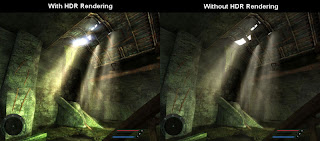Game engineNebula Device
The leading Open Source 3D game and visualisation engine used in dozens of commercial games and professional visualisation applications released worldwide.
Cost
OpenSource, It’s free !
Features
- Graphic Subsystem
Complete rewrite for DX9
Full support for DX7 and DX9 hardware
D3DXEffects (.fx files)
D3D´s HLSL (High Level Shader Language)
- Audio Subsystem
Hundreds of sound sources in a 3d environment
Static and streamed sounds
Simple usage
- Special Effects
Particle System for smoke, fire, sparkles and more
Moving Trees
Shaders for grass, water, glass, metal and more
Fog
Bumpmaps
Realtime Shadows
Prerendered Lightmaps
HDR Rendering
Rendering
High dynamic range rendering (HDRR or HDR Rendering), also known as high dynamic range lighting, is the rendering of 3D computer graphics scenes by using lighting calculations done in a larger dynamic range. Video games and computer generated movies greatly benefit from this as it creates far more realistic scenes than with the previous lighting model (dubbed low dynamic range lighting or standard lighting).

We choose HDR Rendering, because of the better light effects as you can see on the pictures above. Also the shadows have a very clear and dignified outlines, as we want them to look like.
Tone Mapping
Tone mapping, in the context of graphics rendering, is a technique used to map colors from high dynamic range (in which lighting calculations are performed) to low dynamic range that matches the capabilities of a computer display device. Typically, the mapping is non-linear - it preserves enough range for dark colors and gradually limits the dynamic range for bright colors. This technique often produces visually appealing images with good overall detail and contrast. Various tone mapping operators exist, ranging from simple real time methods used in computer games to more sophisticated techniques that attempt to imitate the perceptual response of the human visual system.
Support
Support Resources for this project
This project maintains a number of support resources on SourceForge.net. To help ensure your issue is handled in a timely manner, the nebuladevice project has specified that they prefer for their issues to be reported via
the nebuladevice-discuss Mailing List.
The following resources are active for the nebuladevice project.
Mailing list:
nebuladevice-cvs (Description: Automatic list for CVS changes.);
[Archive] - this mailing list was created by the project
Mailing list:
nebuladevice-discuss (Description: Nebula Device related discussion.);
[Archive] - this mailing list was created by the project
Camera Control
Our game is a first person shooter, so you have a first person view. You are able to look around and see the world through the eyes of the Grazer Kunsthaus.
Sounds
flup - when the Kunsthaus shoots the bubble
Blubb - when the enemy is bubbled
Slurp - when the Kunsthaus eats the wobble
Emotions of the Kunsthaus like “Juhu”, “Jippie”, “That was easy!” (After the successful ending of a mission)
Oh nooo! - If he failures
Tap Tap Tap – while walking
Music for the tutorial level – coming soon
Background music – when it’s thrilling
Voices of friends, guards,
Weather (rain, thunder)
Ambient noise, scrooping doors, keys, ring tones of mobile phones,
Ambience of cities / flowing water in Venice, cars, birds,
Ticking clock – if he has only a short time to solve a problem
…
Game data
The game data will be stored in a “savegames” folder on your hard drive. There are some plotpoints in the game where it will save the actual game progress automatically, so if you die your data won’t be lost. There won’t be any database functionality because the game is single player only so it wouldn’t be necessary to exchange data.
Software/Development requirements
For the game a mp3 codec will be needed to play all the sound files and in game music. We choose the lame mp3 codec which is free for use.
A DIVX codec will also be necessary for the story videos which are not in game sequences but rendered sequences.












 Giovanni Bellini Pala di san giobbe
Giovanni Bellini Pala di san giobbe















